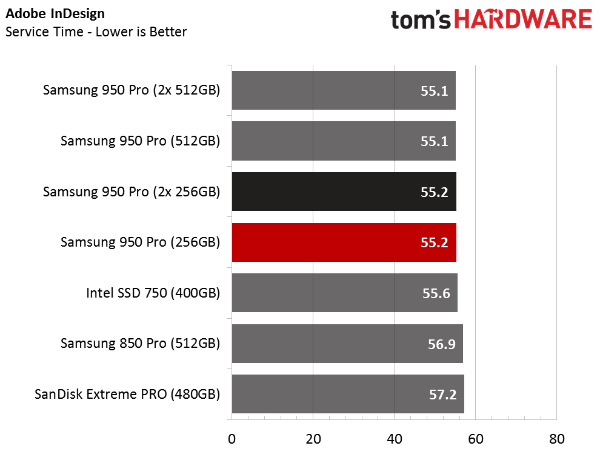Samsung 950 Pro 256GB RAID Report
Why you can trust Tom's Hardware
Real World Software Performance Testing
PCMark 8 Real-World Software Performance










Under normal desktop conditions, application performance actually suffers from the joining of two SSDs in RAID 0 using Intel's DMI. Even the heavy Photoshop test isn't taxing enough to utilize what the array has to offer.
For what it's worth, we're working to add a SolidWorks benchmark. But even that application exposes only small speed-ups in very large files. If you want to get more than extra capacity from your array, you need to work almost exclusively with large files or operate under close to steady state conditions.
Throughput Performance
We were surprised to see the performance of normal software drop when we switched to RAID 0. In an attempt to troubleshoot, we ran a single drive with and without the RAID switch activated, finding that the setting cuts into performance. Thus, we don't think the penalty comes from the array itself.
For now, Intel's Z170 platform controller hub is your only option for booting to a PCIe-based RAID 0 array. Both HP and Dell have add-in cards that accept up to four NVMe SSDs. Neither of them are bootable, though. Liqid, a start-up, is working on an add-in card that also accepts up to four M.2 PCIe SSDs, but we don't know if it is bootable.
PCMark 8 Advanced Workload Performance



As we observed in the steady state tests, RAID 0 will improve the performance of common applications if the member drives are at or close to steady state. This happens a couple of different ways. The first is if the flash is dirty. Garbage collection and wear leveling work to keep pages clean and ready to accept new data. When cells are clean, the controller can write more quickly. When your SSD is nearly full, there are fewer clean cells available, changing the drive's performance.
Total Access Time



Under the same conditions, latency changes as well. Forums are full of conversations about SSDs slowing down over time. The perceived performance loss has to do with the increased latency that comes from dirty cells. Most enthusiasts keep a lot of data on their drives. Using a RAID 0 array helps combat that performance loss over time.
Get Tom's Hardware's best news and in-depth reviews, straight to your inbox.
Current page: Real World Software Performance Testing
Prev Page Mixed Workloads And Steady State Next Page Conclusion
Chris Ramseyer was a senior contributing editor for Tom's Hardware. He tested and reviewed consumer storage.
-
USAFRet Reply17700323 said:Why do you expect gains in video games when everything relevant is loaded in RAM?
A lot of people do.
Assuming that the performance gains we saw with spinning disks in RAID 0 automagically does the same with SSD's. It does not. -
Tibeardius Did it have any sort of thermal throttling occur? These pcie m.2 drives can get pretty hot.Reply -
Integr8d "Once upon a time, you could sling a couple of Western Digital Raptors together, fire up a level in Battlefield 2 before anyone else, get the plane and dominate the map."Reply
Someone just explained 24 months of my life:) -
HT ReplyWhy do you expect gains in video games when everything relevant is loaded in RAM?
that's the point of faster drives, loading it all in ram. do you think it magically appears there by itself ? -
HT good article Chris, i'm intrigued by your statement of the samsung driver vs the M$ one, i would've liked to see some numbers comparing the two.Reply -
Virtual_Singularity Interesting article. Also: am a lil' dumbfounded at how much the price of the 850 pro series has dropped since the holidays, a mere 3+ months ago...Reply
